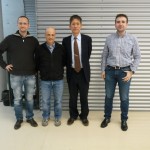Abstract
This presentation focuses on our recent studies of molecular catalysis of water splitting reactions. Our studies involve photochemically, chemically, and electrochemically driven catalysis. Important targets have been to develop molecular catalysts exhibiting an effectively lower overpotential for either water reduction and oxidation process. It is also important to develop fast catalysts as well as methodologies enabling combined use of both catalysts leading to the overall water splitting. Platinum(II) complexes had been for a long time rare examples of molecular catalysts promoting hydrogen evolution reaction (HER) when driven with methylviologen radical (150 meV of driving force for HER at pH 5.0). We were able to realized tetracarboxylate-bridged dirhodium complexes as the second example of molecular catalysts for HER. We further reported that Co-NHC complexes also serve as effective catalysts for HER. Based on modification of EDTA/Ru(bpy)32+/MV2+/Pt(II)-Catalyst (MV2+ = methylviologen) for photocatalytic HER, various types of hybrid molecular systems have been developed to understand the basic principles required to design and fabricate more highly active molecular systems applicable to solar-driven water splitting reactions. These involve dyads, given from a covalent linkage of Ru(bpy)32+ and PtCl2(bpy). They behave as single-molecular photocatalyst driving photo-driven water reduction to H2 by EDTA. Some simple mononuclear Pt(II) complexes, such as those having either Pt(II)Cl(terpy) or Pt(II)Cl2(bpy) unit, were also shown to serve as such photo-hydrogen-evolving molecular devices. Introduction of multiple viologen acceptors to such Pt(II) systems led to greatly improve the net photocatalytic performance. On the other hand, our group also reported on the initiations of new highly active molecular catalysts for water oxidation and the detailed kinetic studies to understand the mechanism of water oxidation catalysis. These involve our recent studies on mono- and di-cobalt molecular catalysts, such as water-soluble cobalt porphyrin water oxidation catalysts. Our recent topics involve intriguing multi-electron storage behaviors demonstrated by dodeca-viologen-tethered Ru(bpy)32+ derivatives. Combined use of such artificial photosynthetic devices is considered to afford some new ways of practically convert solar light energy into hydrogen energy.
